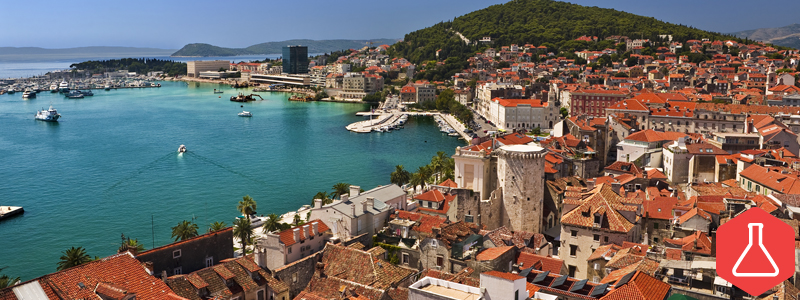In the on-going effort to help Pinot Noir lovers branch out within their palate preferences I have been posting wines that fall into the Pine Cone Alternative category. There are so many out there and little rays of light need to be shined upon them, “[w]arm like the evening sun.” (Mick Jagger/ Shine a Light) So fly with me to our final stop on our tour of Pinot Noir alternatives as we explore the hills of the Croatian coastline.
Warning: this post is so geeky it hurts.
Just across the Adriatic Sea from the eastern coast of Italy is Dalmatia, a smattering of islands immediately off and part of the western coast of Croatia. Here we find our final Pinot Noir alternative. This location is also where the story of Zinfandel begins, but I will go into that in another post — cuz the story is legit. For now, let’s romp through the stoney vineyards of this unrealized region of the world until we get to a coastal town called Split. This, ladies and gents is home to the grape Plavac Mali. This little blue grape (Plavac = blue, Mali = little) has been grown in Croatian soils for thousands of years and has spread throughout Croatia and over the Adriatic to an Italian region called Puglia where they call the grape Primitivo. Yet in the US, Plavac Mali is just starting to gain attention.
While I have an Italian restaurant, political borders do not define terroir, so I offer a few wines from Croatia on the wine list. If someone’s looking for a wine by the glass and is digging some Pinot Noir, we suggest they try Plavac Mali. Although the wines made in this region are difficult to pronounce and intimidating (until they are all the rage that is), such as Dingač (ding-atch) and Postup (po-stoop) — both made from the Plavac Mali (plah-vatz molly) grape — what is inside the bottle is very easy to understand.
In Dalmatia, vines are grown on south facing slopes toward the sea and enjoy that awesome maritime breeze, which is key to cooling the grapes at the right times to ensure bright acidity in the resulting wines. These bottles cost anywhere from fifteen bucks on up and are full of blackberries and dark cherries on the nose with wafts of fresh cracked black pepper and other spices; sometimes you can find a hint of cardamom and a bit of fennel. The body is medium with a soft round palate and subtle tannins. YUM! Perfect for Pinot fans.
Now here is where the grape gets all kinds of crazy. Plavac Mali is the progeny of two native grapes to Croatia, Dobricic (doe-brit-chich) and Crljenak Kaštelanski (tsril/yeh/nak kah/steh/lahn/skee). DNA profiling in the 1990s proved that Crljenak Kaštelanski is, in fact…wait for it…what we know as Zinfandel here in the US. WHOA! Of course what we did in America with Zinfandel is night-and-day compared to the wines from its native home, so don’t let this grapes relation to American Zinfandel confuse your understanding. Plavac Mali is indeed a perfect substitute in wine characteristics for Pinot lovers. So Pinot Noir drinkers unite and get into into this awesome up-and-comer to our wine market.
Živjeli (zhee-vee-ly)! That’s cheers in Croatian. Raise a glass!

